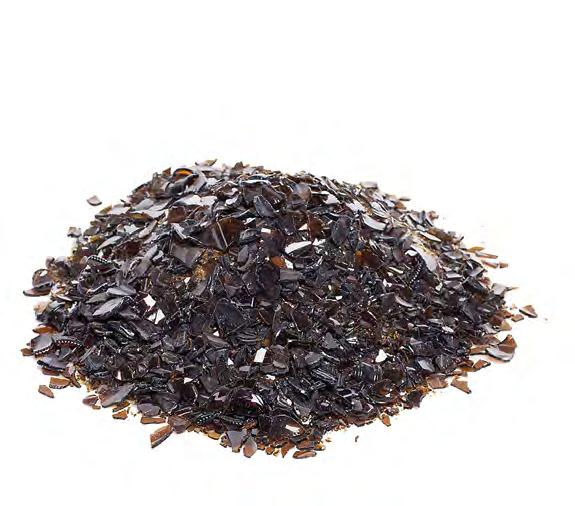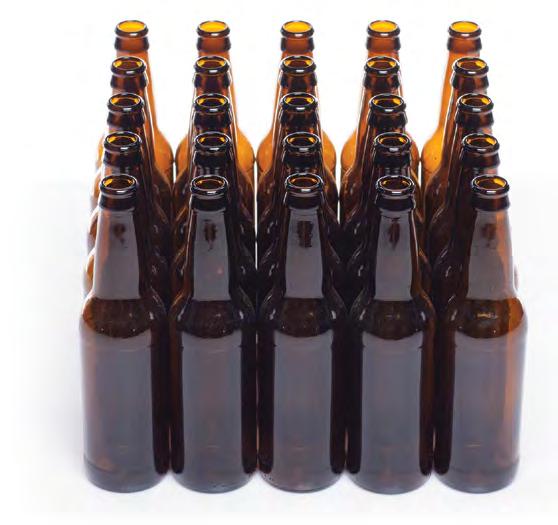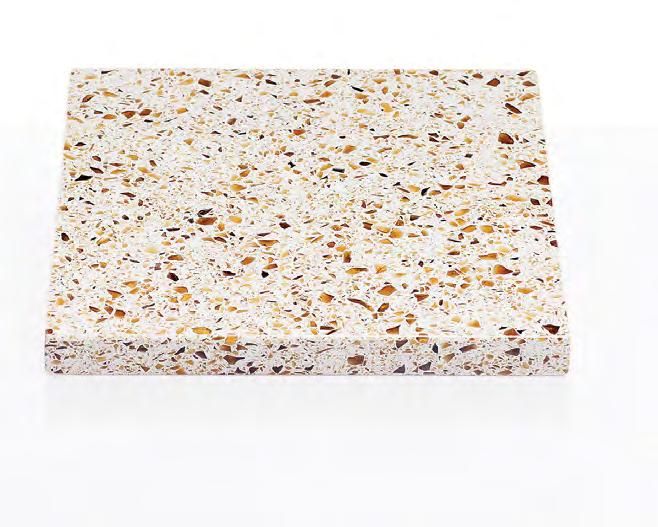
8 minute read
Beyond Beauty: A Deeper Look at Resin-based Recycled Glass Surfaces
Beyond Beauty:
A DEEPER LOOK AT RESIN-BASED RECYCLED GLASS SURFACES
Advertisement
By Paolo Bilotta, Principal, Curava
One look at a recycled glass countertop and there’s no question it’s a bold and beautiful surface that elevates any room with a wow factor.
The translucent quality of striking glass particulates makes it an eye-catching centerpiece for kitchens, baths, bars and other applications. While some recycled glass surfaces have a cementitious base, for the purpose of this article, we will only look at those that are resin-based. These surfaces have a number of qualities that make them a good choice for both fabricators and consumers.
A Niche within the Engineered Stone Category
Recycled glass surfaces that are bound with resin are technically categorized within the engineered stone category and are akin to the quartz surfacing segment of the market. They generally have a similar synthetic resinmatrix These resin-based surfaces offer similar advantages to many of today’s modern hard surfaces. First, the material uses the same equipment and guidelines as those for fabricating quartz, which is relatively common these days. Additionally, resin-based recycled glass surfaces are nonporous and, therefore easy to maintain, require no sealing and can be cleaned using hot water and a pH neutral cleaner. They are also durable, not subject to etching, and are heat-, scratch- and stainresistant. Because they are nonporous, they are resistant to penetration by microbes, making them easy to disinfect.
as a binder, and many also contain a small percentage of quartz particulates.
Answering the Demand for Sustainable Solutions
In today’s society, many people have began embracing the idea of “going green” and are including glass among their recyclables. And while the United States is trailing behind much of Europe in the percentage of glass recycled,
according to Chemical & Engineering News, in 2019, Americans disposed of around 10 million metric tons of glass. However, only a third of that was recycled, and it can take glass up to 1 million years to naturally degrade in the environment. This makes it even more critical to find uses for it. Recycled glass surfaces are one such use that not only diverts glass from the waste stream, but also provides the aforementioned properties.
One of the most outstanding features of recycled glass surfaces is that it is a naturally sustainable product. Recycled glass surfaces are among the most eco-friendly on the market today, with many incorporating glass particulates that are 100 percent recycled from post-consumer and post-industrial sources. The process of developing these surfaces typically starts with the
Resin-based recycled glass surfaces make aesthetically pleasing countertops, such as this one in Curava’s “Wheat” color, while also offering a durable and sustainable option. They fabricate very similarly to quartz or granite and are nonporous making them stain-resistant and easy to clean as well.
collection of hundreds of tons of discarded glass, sourced every month from landfills (discarded glass bottles), glass factory waste (window and shower) and discarded safety glass. Reusing tons of refuse glass removes it from landfills and adds more green power to homes. Some recycled glass surfaces use 25 bottles to produce a single square foot! Many are manufactured using other green-friendly methods to create the product, including zero water waste manufacturing processes.
Fabricators are seeing that sustainability is becoming more critical to today’s buying audiences, and Millennials in particular, who often choose products because they’re good for the planet. According to the U.S. Census Bureau’s most recent estimates, Millennials began to outnumber Baby Boomers in the last census and there are now more than 80 million. Various surveys show that this up and coming generation now account for an estimated $1 trillion of current U.S. consumer spending and growing. These same studies, such as Nielson’s Global Corporate Sustainability Report (www.nielson.com), show 73 percent of this generation is willing to pay extra for sustainable offerings. Recycled glass surfaces are an example of the type of product that would appeal to this discerning buying audience, who put their money where their values are.
Fabricating Recycled Glass Surfaces
Before discussing the actual process, one thing to take into consideration is that with resin-based recycled glass surfaces, silicosis is a greatly diminished factor because the small percentage of quartz in them means they are classified as an amorphous silica, a noncrystalline solid that does not emit silica dust. However, precautions should still be taken, even with a lesser risk than materials with larger amounts of crystalline silica, meaning cutting and fabricating it should be done using wet processes.
To ensure the utmost safety when fabricating recycled glass surfaces, fabricators should closely follow OSHA, local, state and federal regulations. Among those safety guidelines are wearing the proper personal protective equipment (PPE) and following safety procedures for equipment and machinery used.
Handling – One of the most important activities related to working with recycled glass surfaces involves the handling of the slabs and the finished product. Clamp lifters with white rubber padding (to avoid black marks) may be used to lift and move slabs. Slabs should always have the clamp positioned in the center to avoid unbalanced movement upon lifting. Vacuum lifting equipment may be used only to move finished products, not entire slabs.
Storage – Slabs should be stored vertically on A-frames or slab racks, making sure the vertical beams of the A-frames are on the same plane. The bottom and top of the slabs should completely touch the bottom and top of the slabs behind them along the entire length. Slabs should always be stored indoors and without the polished face exposed to sunlight.
Drilling/routing – Faucet hole drilling follows the same process used for quartz and granite. Wet diamond core bits are used applying constant moderate pressure to obtain a smooth hole all the way through the slab. The piece being drilled or cored must be supported on an even, flat surface to minimize blowout. Edges are profiled with a router or CNC machine, following the same process used for nature stone or quartz. An additional recommendation is the use of continuous diamond bits to keep any chipping to a minimum.
Cutting – A bridge saw with blades for granite or quartz should always be used to cut slabs into countertop dimensions. The same is true for blades when cutting with a hand grinder. Once again, these activities should always be done using water.
Sinks – It is mandatory to support all sink cutouts in the front and back if the distance from the sink cutout edge to finished edge is less than 4 in. Undermount sinks may be installed with the same process used for granite or engineered stone. Silicone should be used to adhere the sink edge to the back of the cut material, along with clips to secure the sink to the threaded anchor embedded into the material.
Patching – Occasionally glass chipping may occur, which is very simple to remedy by patching with either clear epoxy glue, clear polyester mastic or a UV-light stone repair kit (the latter is preferred as patching is transparent). Knife grade polyester mastic is an easy patching material if the voids are small because it spreads well and is the easiest to match with the slab color.
Recycled glass surfaces, such as Curava, take used sources of glass, such as beer bottles, window glass and others that might otherwise enter landfills, crushes them and uses them to manufacture a beautiful and functional product.



or those that can be colored. Fabricators can either color the resin to match the color of glass in the surface or leave the resin clear. Fabricators can decide which patching material will give the best visual result and should test options first. Once tested, the selected resin should be applied with a spatula until the void is filled completely and the excess shaved off with a razor blade after it is cured .
Edge polishing – As with granite or quartz edges, use diamond pads and water. Do not apply wax to the surface as that will dull the glass and reduce the quality of the polish. The recommended polishing sequence is as follows, by grit: 50, 100, 200, 400, 800, 1500, 3000, buffing pad. It should always be wet polished, never dry polished.
The Whole Package
Recycled glass surfaces offer a host of benefits that make it a suitable choice for fabricators and consumers alike. Fabricating very similar to quartz/stone, it is a durable and low-maintenance option. And, because it was excluded from the tariffs placed over the past couple of years on Chinese imports, manufacturers and distributors can maintain affordable pricing. This allows the material to fall in the cost area of mid-range granite.
These qualities, along with its eye-catching beauty and sustainable makeup, allow today’s consumers who want to embrace both aesthetics and the green movement a great opportunity to do so. As such, fabricators who want this business have a good option to capture it by offering this category of products.
About the Author

Paolo Bilotta is the principal of Curava Corporation, a family-owned and operated manufacturer and distributor of recycled glass surfaces. He shares his family’s entrepreneurial spirit and craftsmanship to offer this line of beautiful, high-quality and eco-friendly surfaces. For more information visit www.curava.com, call (603) 262-1487 or email info@curava.com.










